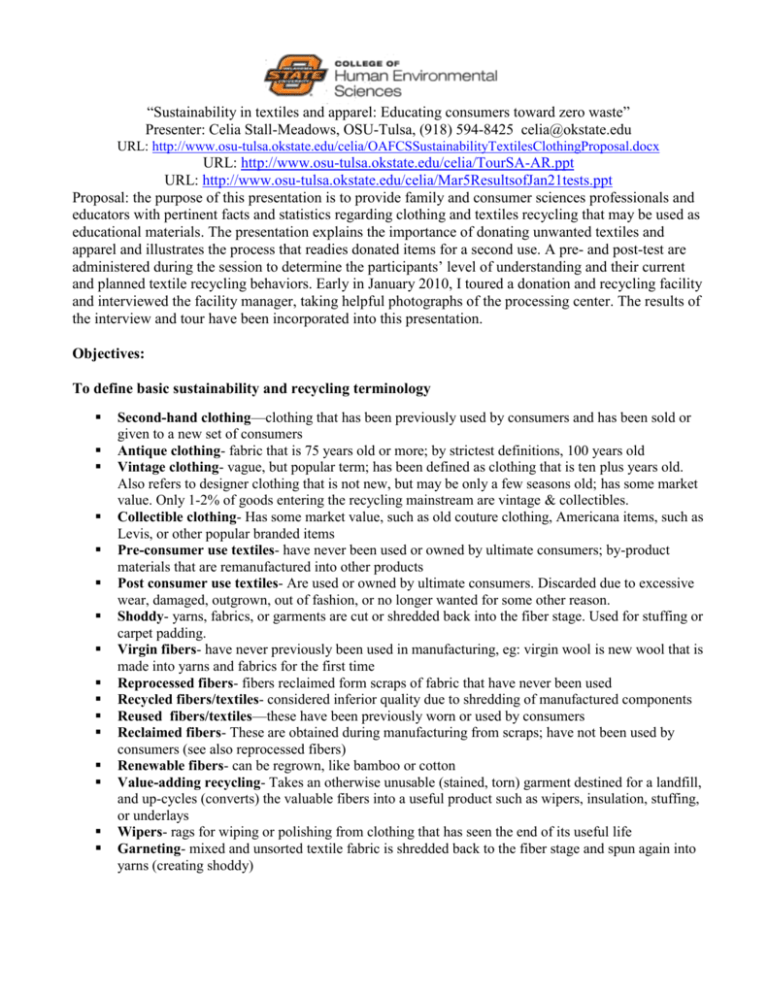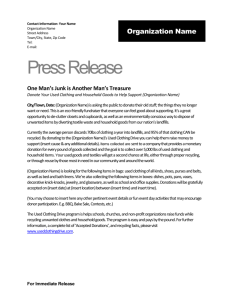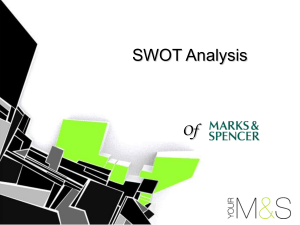
“Sustainability in textiles and apparel: Educating consumers toward zero waste”
Presenter: Celia Stall-Meadows, OSU-Tulsa, (918) 594-8425 celia@okstate.edu
URL: http://www.osu-tulsa.okstate.edu/celia/OAFCSSustainabilityTextilesClothingProposal.docx
URL: http://www.osu-tulsa.okstate.edu/celia/TourSA-AR.ppt
URL: http://www.osu-tulsa.okstate.edu/celia/Mar5ResultsofJan21tests.ppt
Proposal: the purpose of this presentation is to provide family and consumer sciences professionals and
educators with pertinent facts and statistics regarding clothing and textiles recycling that may be used as
educational materials. The presentation explains the importance of donating unwanted textiles and
apparel and illustrates the process that readies donated items for a second use. A pre- and post-test are
administered during the session to determine the participants’ level of understanding and their current
and planned textile recycling behaviors. Early in January 2010, I toured a donation and recycling facility
and interviewed the facility manager, taking helpful photographs of the processing center. The results of
the interview and tour have been incorporated into this presentation.
Objectives:
To define basic sustainability and recycling terminology
Second-hand clothing—clothing that has been previously used by consumers and has been sold or
given to a new set of consumers
Antique clothing- fabric that is 75 years old or more; by strictest definitions, 100 years old
Vintage clothing- vague, but popular term; has been defined as clothing that is ten plus years old.
Also refers to designer clothing that is not new, but may be only a few seasons old; has some market
value. Only 1-2% of goods entering the recycling mainstream are vintage & collectibles.
Collectible clothing- Has some market value, such as old couture clothing, Americana items, such as
Levis, or other popular branded items
Pre-consumer use textiles- have never been used or owned by ultimate consumers; by-product
materials that are remanufactured into other products
Post consumer use textiles- Are used or owned by ultimate consumers. Discarded due to excessive
wear, damaged, outgrown, out of fashion, or no longer wanted for some other reason.
Shoddy- yarns, fabrics, or garments are cut or shredded back into the fiber stage. Used for stuffing or
carpet padding.
Virgin fibers- have never previously been used in manufacturing, eg: virgin wool is new wool that is
made into yarns and fabrics for the first time
Reprocessed fibers- fibers reclaimed form scraps of fabric that have never been used
Recycled fibers/textiles- considered inferior quality due to shredding of manufactured components
Reused fibers/textiles—these have been previously worn or used by consumers
Reclaimed fibers- These are obtained during manufacturing from scraps; have not been used by
consumers (see also reprocessed fibers)
Renewable fibers- can be regrown, like bamboo or cotton
Value-adding recycling- Takes an otherwise unusable (stained, torn) garment destined for a landfill,
and up-cycles (converts) the valuable fibers into a useful product such as wipers, insulation, stuffing,
or underlays
Wipers- rags for wiping or polishing from clothing that has seen the end of its useful life
Garneting- mixed and unsorted textile fabric is shredded back to the fiber stage and spun again into
yarns (creating shoddy)
To explain municipal and charitable recycling programs
a. Textiles are sorted
i. Collectibles are extracted and sold at a higher profit
ii. Other used clothing may be sold in resale shops
iii. Rags may be sold as wipers
iv. Shoddy fibers are created by shredding and used for stuffing
b. Used clothing is baled (from 600 to1600 pound bales)
c. Bales are sold by the pound to resellers or reprocessors (approx. 15-20 cents/pound)
To trace the global travels of a bundle of donated clothing
1. T-shirts and other items are discarded by first owners
2. Shirts and clothing are donated to Salvation Army, Goodwill, or other charitable
organization
3. The organizations may sell the nicer items in a resale shop
4. Unsold clothing and unwanted textiles are baled, often as “unsorted rags”
5. Bales are transported to processing centers near domestic ports, such as Houston
where the unsorted gets sorted
6. Nicer quality clothing, such as shirts may be bundled with other goods in large,
rectangular bales (refrigerator size or larger) that are shipped in containers to foreign
ports
7. May be sold or smuggled (if protectionist measures prohibit importing secondhand
clothing) into countries in an opaque plastic-wrapped bale the size of a large
refrigerator
8. Local dealers obtain the bundle and cut open the $90-$250 bundle (depends on the
weight)
9. Dealers sort through the variety of items for those that will be most desired
10. Although the charity intended all the clothing to be donated to poor, aged, and ill,
some of it may be circumvented by businesspersons
11. Much of it may be sold at low prices to the country’s economically disadvantaged,
since new clothing cannot be produced as cheaply as using clothing can be shipped.
This may negatively affect the country’s new apparel industry
To explain the benefits of textile and clothing recycling
Reduces landfill dumping
Charitable contribution and deduction
Funds charitable work, such as drug and alcohol rehabilitation
Disaster relief
Demonstrates sustainability and environmentalism and reduces a carbon footprint
Healthy for economic development around the world; many micro businesses are created as
used-clothing stalls throughout the world
Sizable market for used American clothing in foreign countries
Used clothing may be only source of affordable clothing in many developing countries
To identify the drawbacks of textile and clothing recycling
Used clothing may create health risks/spread of skin diseases
Used Western clothing may threaten traditional dress for indigenous cultures
Used Western clothing may threaten fledgling textile & apparel industries in developing
countries; protectionist measures may create black markets for used apparel
Some recycling companies don’t want donated textiles, because they are difficult to sort, have a
mixture of fibers (polyester/cotton), not much fiber comes from any one item, and shredding
textiles is difficult because they tend to get tangled in the shredder.
To identify future trends and viable, value added markets for reclaimed textiles
As the standard of living improves in developing countries, citizens will have more discretionary
income with which to purchase used clothing and textiles, and demand will increase.
As the price of new clothing decreases for U.S. consumers, our consumption increases and
disposal increases. Currently, clothing prices increase at a rate less than the increases in
consumer income. The consumer price index shows that clothing expenditures as a percent of a
consumer’s total expenditures continue to decrease. This means we are paying less and less each
year for the same clothing items. We may refer to this as “disposable clothing.”
To identify consumer options for disposing of unwanted textiles
Landfills- avoid throwing out any textiles, since even those that might be considered “rags” may
have some use and value. Textiles, even biodegradable natural fibers, do not easily degrade
under landfill conditions due to lack of sunlight and oxygen.
Incineration-avoid this, since it contributes to air pollution
Composting- will work with natural fibers (cotton, linen, wool, silk) but zippers, buttons, etc.
must be removed. Better to donate.
Garage sales- good market for used clothing
Resale shops- resale shop may buy the item outright or offers consignment plan
Charities-best choice for apparel donations and it is tax deductible (get receipt)
o Avoid contributing excessive amounts of textiles and apparel during disasters
o Relief agencies are overwhelmed with donations
o Unable to process the vast quantity due to:
Time constraints
Transportation logistics
Personnel shortages needed to sort, clean & distribute
o Best to limit donations to non-disaster times. Donate regularly, but not excessively.
Clothing must remain dry so it won’t mildew and ruin.
To provide alternatives to overconsumption of textiles and apparel
Consider borrowing from a friend for a one-time event
Shop at a charity resale shop that donates the proceeds to a worthy cause
Think twice before buying…Do I really need it?
Avoid impulse buying
Consider having furniture recovered in new fabric rather than buying a new piece
Purchase basics and staples
Overcome the notion of thinking that “used” clothing is somehow inferior to “new” clothing
Shop your favorite resale shop on a regular basis for the best “finds”
Learn to mix and match; Be creative!
To provide other ideas for reducing consumption
Manufacturers may reduce packaging for shipment of new garments to stores. For example,
men’s dress shirts previously were folded with plastic tabs under the collar, cardboard tabs inside
the neckline, cardboard square to support the folded shirt, multiple pins, a hangtag, and a plastic
cover
Refuse to take a plastic bag when shopping
Retailers can offer incentive for customers NOT to take a sack (eg: five cent discount)
To make recommendations for family and consumer sciences professionals
Contact county (local) charities, resale shops (eg: Goodwill) and ask how each of these
organizations process/dispose of donated textiles. There should be no waste.
Consider organizing a clothing drive; let consumers know that clothing can be almost 100%
recyclable. Throw nothing away. Let the experts decide what to keep and what to toss.
Encourage donation of clothing, bric-a-brac, furniture, etc. to charities such as Salvation Army
Consider organizing a field trip or enlisting a guest speaker from one of the sustainable
organizations listed at www.oksustainability.org/guide/all.php
Sources:
Hawley, J. (2006, July). Digging for diamonds: A conceptual framework for understanding reclaimed
textile products. Clothing & Textiles Research Journal, 24 (3), 262-275.
Hawley, J. (2008). “Economic impact of textile and clothing recycling.” In Hethorn, J. & Ulasewicz, C.
Sustainable fashion: Why now? pp. 207-230.
Kadolph, S. (2007). Textiles. Upper Saddle River, NJ: Pearson Prentice Hall.
Overton, T. (2010, Jan. 10). Personal interview. Tulsa Adult Rehabilitation Center, Salvation Army.
Stall-Meadows, C. (2010). Fashion Now: A global perspective. Upper Saddle River, NJ: Pearson
Prentice Hall.
Online Resources:
“Wastes-Resource Conservation-Common Wastes and Materials-Textiles.” (2009). Environmental
Protection Agency www.epa.gov/osw/conserve/materials/textiles.htm
Secondary Materials and Recycled Textiles Association (SMART). (2009). www.smartasn.org
Oklahoma Sustainability Network resource guide. www.oksustainability.org/guide/all.php
Council for Textile Recycling. www.textilerecycle.org
Youtube video by SMART http://www.youtube.com/watch?v=7q8oTWpQCUA






